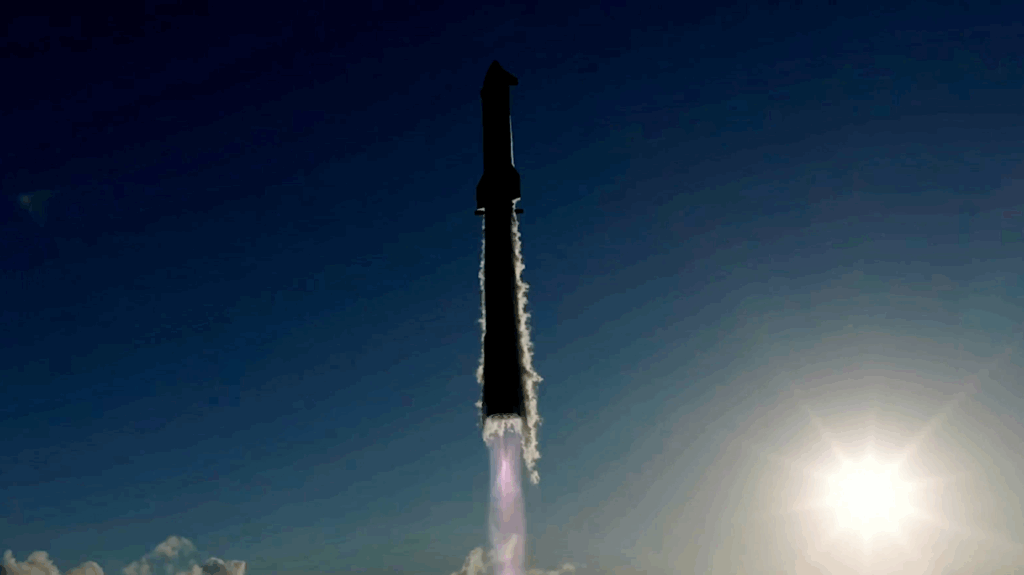How SpaceX Is Perplexing NASA
 Keith’s note: The other day I had someone of senior stature with decades of aerospace engineering experience at NASA ask me which of several pictures of Starship floating around social media were real and which are faked. One image was tweeted by Elon Musk at Boca Chica. Another tweeted pic was a deftly done Photoshop image of what Starship will look like when it is all done in a week or so. The person I spoke with told me that they had a problem separating Photoshop from reality while following your progress.
Keith’s note: The other day I had someone of senior stature with decades of aerospace engineering experience at NASA ask me which of several pictures of Starship floating around social media were real and which are faked. One image was tweeted by Elon Musk at Boca Chica. Another tweeted pic was a deftly done Photoshop image of what Starship will look like when it is all done in a week or so. The person I spoke with told me that they had a problem separating Photoshop from reality while following your progress.
My response: “This is what happens when rapid prototyping happens in plain sight – in real time. Would NASA ever build a rocketship outside? Would NASA ever build a rocket in a few months – and then fly it – with a live webstream? Why are they photoshopping it? Because they can’t wait to see it fly. Do you see people camped outside of SLS assembly sites eagerly awaiting the addition of every little piece? Have I answered your question?”
|
|









Well, assuming his question is not rhetorical, the easiest way to see what is real is to checkout the 24 hour live webcam aimed at the build site. Search for LabPadre on youtube should do it, his channel has the best live camera view.
WOW! Just WOW!
That guy on the tweet clearly said he was editing the picture.
If SpaceX actually lifts this off in the next few months, even if it’s just a short hop, NASA will look like fools. They just plunked down $3 billion for three Orion capsules when they could have had three fully reusable Starships for the same price.
It is unlikely each Starship costs SpaceX more than $200M fitted out.
It more like 15 to 30 Starships depending on the unit procurement cost of the Starship.
I was being generous. But they will have to lift the Starship with a SpaceX Super Heavy first stage (I think). Not sure of the total stack cost.
SpaceX should undercut the competition just slightly in price. It’ll still be a much better deal than SLS/Orion.
The advantage of a Vertical Launch-Vertical Landing is that you are able to do incremental testing. The Starship Mk1 should be starting it’s suborbital flights next month at Boca Chica with the eventual goal of reaching space in a few months. Then the Super Heavy will be tested in suborbital flights at the Cape, probably alongside the Starship Mk2 being built in Florida. Then the two will be put together and go for orbit.
It’s hard to believe the progress in just a year. With luck by this time next year the operational cargo Starship will be flying. It will be very hard for NASA to ignore a rocket larger than the SLS, even larger than the Saturn V launching to orbit every few weeks. It is going to blow NASA’s mind. A rocket launching regularly that will be able to carry twice as many people (100+) to orbit as compose the Entire NASA Astronaut corps (44) with room left over for a dozen ESA astronauts.
It makes the Orion look like a raft made out of Balsa Wood.
It’s a one time procurement cost, Ken . Like you buying a big Dodge Ram pickup truck but not having to throw it away every time you drive it. $ 75 worth of gasoline , check the tires, and yer good to go again. End up amortizing your cost-over-life to a few dollars per excursion . Starship and SuperHeavy do that. Not so SLS… years to build, and a billion dollars to use once and throw it away. Boeing gets to laugh all the way to the bank a couple times before their services are no longer needed. Which is a very good thing…
Perhaps the real news of the day was Lockheed getting a $ 5 billion cost plus sweetheart deal to build six more Orion capsules, with no rocket to put under them yet. That is not a good thing. Eisenhower warned us about this in his final address to Congress way back in 1960.
No doubt, that’s why I said NASA will look like fools. Not a month or two after a high dollar deal, a game changer much better deal takes flight.
Orion R&D (~$16 billion) + 3 copy (~$2.7 billion) = ~$19 billion.
SpaceX: Falcon 1 + Falcon 9 (v1.0 to Block5) + Falcon Heavy + StarShip + SuperHeavy + Draco + SuperDraco + Kestrel + Merlin (1A to 1D) + Raptor + Dragon 1 + Dragon 2 + Crew Dragon + Reusability R&D = ~$10 billion.
But that is only the Orion command module? The SM is being developed and built by ESA. SLS is an additional ~$16 billion.
The $enate Launch $ystem is now a joke.
Looks like an exciting sci-fi movie. Three or four generations waiting for the SLS to get ready. And Nasa claiming Elon’s colonization of Enceladus is too risky.
We have been through this before, when the home brew PC crowd displaced the old Mainframe Computer world. IBM learned to “dance” and survived. The question is will NASA learn to dance or will it cling to the old ways and become irrelevant when SpaceX starts taking tour groups to the Moon and beyond?
it kind of depends on which “NASA” you are talking about. NASA is a conglomeration of several organizations, each with its own culture. The manned space agency centered in Texas might have trouble adapting, but the unmanned space agency centered on JPL would not miss a beat.
I’m not convinced of that. JPL (and Goddard) have a real preference for directed (i.e. assigned by Headquarters rather than competed) missions, and for flagship rather than smaller missions. Of course, even JPL and GSFC aren’t monolithic, but a significant number of people there think in those terms (or make presentations which imply they do.) They are also very reluctant to accept things like higher risk and much lower cost small, robotic spacecraft.
I’ve heard several people from those institutions say that the goal is to never have a mission failure. In one case, I tried to argue that, given the difference in cost, we might be talking about 16 successes and 4 failures, versus 9 successes and 1 failure, and 16 is greater than 9. The person I was talking to (from JPL and involved in a small spacecraft planetary mission) did not dispute those numbers. She just said that was the wrong way to think about things; that if it’s your mission you have a responsibility, both to yourself, your team and the tax payers, to make sure it works.
She just said that was the wrong way to think about things; that if it’s your mission you have a responsibility, both to yourself, your team and the tax payers, to make sure it works.
This attitude actually makes sense, though, and not just because of political pressures. The planetary science program cannot be considered in the aggregate – every mission has a specific target or targets, and the scientists overseeing the mission have much or all of their scientific careers to devoted to those targets.
If Dragonfly goes bust, a lot of Elizabeth Turtle’s research life goes bust, too. NASA only sends a probe to Saturn once a generation (and no one else does, period, at least so far). That NASA might also be sending out major missions at the same time to Psyche, Lucy, Mars, and Europa won’t be any help to her.
And this would still be basically true if NASA ran planetary science on a higher tempo, higher failure rate model. Unless you can guarantee each science team multiple bites at their particular apple, the incentive they will be responding to is: We only get one shot at this, so we need to make sure it works.
The hope for the future is that industry can could reduces both launch and bus costs to the point where (many, not all) missions could eventually be done on something like a mass production scale.
The problem is NASA is ran like a 1930’s public works project. It’s meant to leverage jobs in every congressional district through it’s contractors. That shouldn’t be the driving purpose of anything that is nimble and adaptable. It can’t compete with that as a driving force.
They’re gonna be even more perplexed in a few more days now.
Someone forgot to tell NASA that Starship trips are supposed to be multigenerational, not the build.
Exactly.
SLS is the modern day equivalent of a medieval cathedral, a multi generational project though with out the inspiring stain glass and stonework.
Keith, this is really an excellent article! It summarizes the frustrations many of us have about NASA after living through the landing on the moon years of the 1960s. Keep up the great work!
I can tell the difference between the Photoshop ones and the real ones just fine. The photoshop Starships aren’t all crinkly and are sitting where you will never see Orion…ON Mars!
BTW, I know I’ve mentioned this before, but the Science Fiction fan base gives away several scale models of Starship every year. They have for decades. They call them Hugo Awards. 😉
SLS is our generation ship. 🙂
Everyone’s comments here ironically ties the SLS in with romance and adventure. (reality is not as entertaining)
Wow. I never thought of the SLS as a generation ship before.